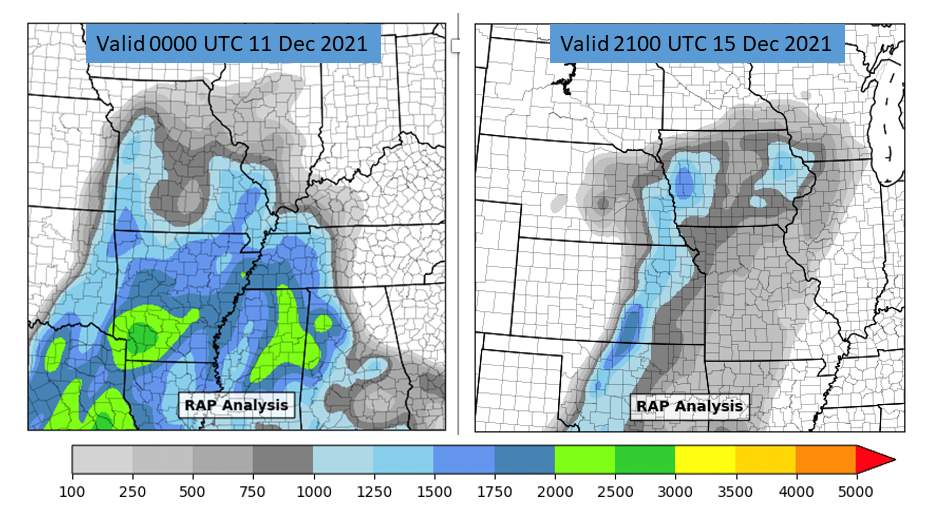Rapid Refresh

Above: RAP analysis of surface-based CAPE (J/kg) valid 0000 UTC 11 Dec 2021 (left, Kentucky tornado event) and 2100 UTC 15 Dec 2021 (right, IA/NE severe weather event).
The Rapid Refresh system (RAP) is an hourly-updated assimilation/modeling system running at 13 km resolution, developed at NOAA's Global Systems Laboratory (GSL). The RAP covers North America and is comprised of a numerical forecast with the Advanced Research WRF (WRF-ARW) model and an data assimilation system using the NCEP Gridpoint Statistical Interpolation (GSI) analysis. The RAP is complemented by the higher-resolution 3km High-Resolution Rapid Refresh (HRRR) model, which is also updated hourly and covers a smaller geographic domain. More information and hourly graphics from the RAP can be viewed at GSL's RAP home page; HRRR information and graphics can be obtained at GSL's HRRR home page.
RAP History at NCEP:
- RAPv1 - implemented 1 May 2012 at NCEP (replacing the Rapid Update Cycle - RUC )
- RAPv2 - implemented 25 Feb 2014 at NCEP
- RAPv3 - implemented 23 Aug 2016 at NCEP
- RAPv4 : Implemented on 12 July 2018
- RAPv5 - Implemented on 2 December 2020
The December 2, 2020 implementation was the last RAP upgrade at NCEP. Development is underway on the future Rapid Refresh Forecast System (RRFS), a convection-allowing ensemble forecast system with this projected configuration:
- Based on the limited area FV3 dynamic core
- Rapidly updated and convection-allowing (~3 km grid-spacing)
- Ensemble-based data assimilation
- Ensemble forecast
- 18 h forecast every hour
- 36-60 h forecast every 6 hours
The RRFS is intended to facilitate the replacement of all current mesoscale systems in NCEP Production: NAM/NAM nests, RAP/HRRR, and HiResW/HREF in ~2024.
A chronological listing from 1993-present of all EMC Mesoscale Model upgrades, including all RUC/RAP/HRRR implementations, can be found at the EMC Mesoscale Model reference web site.
A description of versions 1-3 of the RAP can be found in Benjamin et al. 2016, A North American Hourly Assimilation and Model Forecast Cycle: The Rapid Refresh. Mon. Wea. Rev., 144, 1669-1694.
Official RAP and HRRR graphics from the operational runs can be found at the NCEP Model Analysis and Guidance (MAG) web site.

Above: RAP analysis of surface-based CAPE (J/kg) valid 0000 UTC 11 Dec 2021 (left, Kentucky tornado event) and 2100 UTC 15 Dec 2021 (right, IA/NE severe weather event).
The Rapid Refresh system (RAP) is an hourly-updated assimilation/modeling system running at 13 km resolution, developed at NOAA's Global Systems Laboratory (GSL). The RAP covers North America and is comprised of a numerical forecast with the Advanced Research WRF (WRF-ARW) model and an data assimilation system using the NCEP Gridpoint Statistical Interpolation (GSI) analysis. The RAP is complemented by the higher-resolution 3km High-Resolution Rapid Refresh (HRRR) model, which is also updated hourly and covers a smaller geographic domain. More information and hourly graphics from the RAP can be viewed at GSL's RAP home page; HRRR information and graphics can be obtained at GSL's HRRR home page.
RAP History at NCEP:
- RAPv1 - implemented 1 May 2012 at NCEP (replacing the Rapid Update Cycle - RUC )
- RAPv2 - implemented 25 Feb 2014 at NCEP
- RAPv3 - implemented 23 Aug 2016 at NCEP
- RAPv4 : Implemented on 12 July 2018
- RAPv5 - Implemented on 2 December 2020
The December 2, 2020 implementation was the last RAP upgrade at NCEP. Development is underway on the future Rapid Refresh Forecast System (RRFS), a convection-allowing ensemble forecast system with this projected configuration:
- Based on the limited area FV3 dynamic core
- Rapidly updated and convection-allowing (~3 km grid-spacing)
- Ensemble-based data assimilation
- Ensemble forecast
- 18 h forecast every hour
- 36-60 h forecast every 6 hours
The RRFS is intended to facilitate the replacement of all current mesoscale systems in NCEP Production: NAM/NAM nests, RAP/HRRR, and HiResW/HREF in ~2024.
A chronological listing from 1993-present of all EMC Mesoscale Model upgrades, including all RUC/RAP/HRRR implementations, can be found at the EMC Mesoscale Model reference web site.
A description of versions 1-3 of the RAP can be found in Benjamin et al. 2016, A North American Hourly Assimilation and Model Forecast Cycle: The Rapid Refresh. Mon. Wea. Rev., 144, 1669-1694.
Official RAP and HRRR graphics from the operational runs can be found at the NCEP Model Analysis and Guidance (MAG) web site.